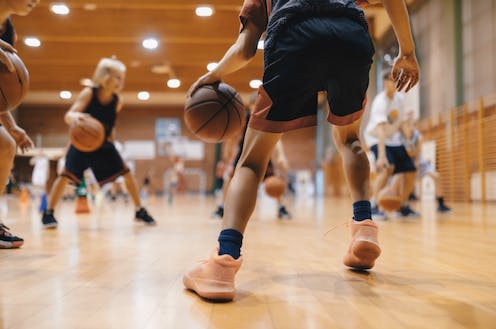
Organized sport is often positioned as a remedy for the many health issues that Indigenous Peoples face. While there are many benefits to sports participation, overstating those benefits risks obscuring the systemic problems they endure in trying to create their own visions for health.
While research indicates that encouraging youth to be engaged in sport and physical activity is essential for improving health outcomes, the relationship between sport participation and health in Indigenous communities is not so simple.
For instance, a recent literature review by the National Collaborating Centre for Indigenous Health calls attention to a significant policy problem: Indigenous youth are more physically active than non-Indigenous youth, and yet they self-report poorer health outcomes.
This illustrates why using sport participation as a policymaking lodestar for affecting positive health outcomes is troublesome. Sport has historically failed to address the systemic issues that burden Indigenous Peoples and their communities. To address these deep-seated issues, a more comprehensive and culturally grounded approach to sport policy is needed.
Table of Contents
National sport policies
National sport policies are important because they serve as a guide for how and why the federal government will invest in sport. Canada’s first sport policy, An Act to Encourage Fitness and Amateur Sport, dates back to 1961. It mostly featured cost-sharing agreements with the provinces and territories to get people involved in sport for fitness and competition.
After that, the federal government began to focus increasingly on high performance sport. Since the 1970s, billions of dollars have been invested in athletes to win gold, silver and bronze medals, as if their accolades would stimulate greater physical activity among citizens.
The overall orientation of these policies is captured by the expression “from playground to podium” — a fitting summary of the reach and ambition of most of them.
Now, a new national sport policy is on the immediate horizon, and with it will come a renewed discussion regarding the connection between health and sport in Canada. The consultation report that forms the basis for the new policy refers to sport as an “integral component of health and culture in Canada,” with quotes throughout that describe it as a form of health care.
Sport and health
The relationship between sport participation and federal policymaking is longstanding and rooted in the conventional wisdom that encouraging youth to be engaged in sport reliably leads to better health outcomes.
For instance, the first goal of the 2002 Canada Sport Policy aimed to significantly increase the number of Canadians participating in sport, saying sports participation “contributes to healthier, longer, and more productive lives.”
The 2012 Canadian Sport Policy continued to highlight the positive health benefits of sports participation, saying it “strengthens their personal development, provides enjoyment and relaxation, reduces stress, improves physical and mental health, physical fitness and general well-being, and enables them to live more productive and rewarding lives.”
Clearly the 2012 policy meant health in a wide sense. These were grand claims, considering only 34 per cent of Canadians participated in some form of organized sport in 2012. By 2023, that number rose to almost 50 per cent, due in large part to return-to-play initiatives after the COVID-19 pandemic — a trend that may be in reverse due to the rising cost of living.
For Indigenous Peoples, there is no official survey that tracks Indigenous participation in sport in Canada. This means assumptions about sport being a driver for Indigenous health may not be relevant for many segments of the First Nations, Métis and Inuit populations. It also means sport policy may exacerbate their existing health inequities, instead of addressing them.
Social determinants of Indigenous health
Although sport is an important and valued aspect of Canadian life, the relative impact it can have on the overall health of a community is tempered by many external factors — a point illustrated by the federal government’s public health resources.
Approaching sport from a social determinants of Indigenous health perspective would shed light on why and how this happens. The Canadian government currently uses the 12 social determinants of health and health inequalities to guide its policies.
The social determinants of Indigenous health go beyond the government’s current approach to include assessments of other negative factors like settler colonialism, as well as positive factors like Indigenous culture and spirituality.
Likewise, Call to Action 89 of the Truth and Reconciliation Commission urges decision-makers to embrace a broader perspective of sport that engages health. It states:
“We call upon the federal government to amend the Physical Activity and Sport Act to support reconciliation by ensuring that policies to promote physical activity as a fundamental element of health and well-being, reduce barriers to sports participation, increase the pursuit of excellence in sport, and build capacity in the Canadian sport system, are inclusive of Aboriginal peoples.”
Dangers of sport evangelism
Without critically considering how we frame sport’s role in Canadian life, any new policy risks the dangers of sport evangelism: the false belief that sport alone can provide a miraculous fix for social and structural issues.
The long list that makes up the social determinants of Indigenous health is a visible reminder of the need to understand sport in that complex matrix.
In both mainstream and Indigenous communities across Canada, sport is neither inherently good nor bad. Rather, it is a tool that must be used responsibly. This requires us to acknowledge both its potential and limitations for enriching the lives of its participants, especially those who we know face health inequities, as Indigenous Peoples do.
![]()
Taylor McKee receives funding from the Social Sciences and Humanities Research Council of Canada
Janice Forsyth is affiliated with the Aboriginal Sport Circle, a national non-profit that focuses on Indigenous sport development in Canada.
























